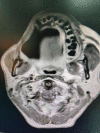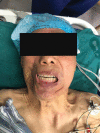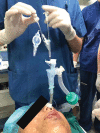Sufentanil, dexmedetomidine combined with surface anesthesia for awake fiberoptic nasotracheal intubation in the patient with severe mouth opening difficulty undergoing wedge resection of the right upper lung: A case report and literature review
- PMID: 37083762
- PMCID: PMC10118371
- DOI: 10.1097/MD.0000000000033584
Sufentanil, dexmedetomidine combined with surface anesthesia for awake fiberoptic nasotracheal intubation in the patient with severe mouth opening difficulty undergoing wedge resection of the right upper lung: A case report and literature review
Abstract
Background: Severe mouth opening difficulty may increase the risk of airway management during anesthesia induction, and awake fiberoptic nasotracheal intubation (AFNI) is the first option for patients with orofacial anatomical changes.
Case summary: A 54-year-old man was scheduled to undergo wedge resection of the right upper lung in August 2021. The patient had a history of enlarged right maxillary lesion resection and partial right maxillary resection surgery in April 2020, which led to orofacial anatomical changes and severe mouth opening difficulty. To avoid difficult airway-related emergency scenarios, the AFNI was successfully performed through intravenous injection of sufentanil and dexmedetomidine combined with lidocaine topical anesthesia under a conscious state without any uncomfortable feeling or complications.
Conclusions: Intravenous injection of sufentanil and dexmedetomidine combined with lidocaine topical anesthesia can be used as an alternative medication scheme to relieve uncomfortable suffering for AFNI in patients with severe mouth opening difficulty.
Copyright © 2023 the Author(s). Published by Wolters Kluwer Health, Inc.
Conflict of interest statement
The authors have no funding and conflicts of interest to disclose.
Figures




Similar articles
-
Dexmedetomidine-midazolam versus Sufentanil-midazolam for Awake Fiberoptic Nasotracheal Intubation: A Randomized Double-blind Study.Chin Med J (Engl). 2015 Dec 5;128(23):3143-8. doi: 10.4103/0366-6999.170260. Chin Med J (Engl). 2015. PMID: 26612286 Free PMC article. Clinical Trial.
-
Effectiveness of mouthpiece nebulization and nasal swab stick packing for topical anesthesia in awake fiberoptic nasotracheal intubation.J Med Assoc Thai. 2007 Oct;90(10):2063-71. J Med Assoc Thai. 2007. PMID: 18041425
-
Comparison of dexmedetomidine and sufentanil for conscious sedation in patients undergoing awake fibreoptic nasotracheal intubation: a prospective, randomised and controlled clinical trial.Clin Respir J. 2014 Jan;8(1):100-7. doi: 10.1111/crj.12045. Epub 2013 Oct 1. Clin Respir J. 2014. PMID: 23906186 Clinical Trial.
-
Awake Fiberoptic Intubation Protocols in the Operating Room for Anticipated Difficult Airway: A Systematic Review and Meta-analysis of Randomized Controlled Trials.Anesth Analg. 2019 May;128(5):971-980. doi: 10.1213/ANE.0000000000004087. Anesth Analg. 2019. PMID: 30896601
-
[Awake video laryngoscopy - an alternative to awake fiberoptic intubation?].Anasthesiol Intensivmed Notfallmed Schmerzther. 2016 Nov;51(11-12):656-663. doi: 10.1055/s-0042-102798. Epub 2016 Nov 24. Anasthesiol Intensivmed Notfallmed Schmerzther. 2016. PMID: 27884026 Review. German.
References
-
- Campos JH. Which device should be considered the best for lung isolation: double-lumen endotracheal tube versus bronchial blockers. Curr Opin Anaesthesiol. 2007;20:27–31. - PubMed
-
- Young RJ, Brown NJ, Reed MW, et al. . Angiosarcoma. Lancet Oncol. 2010;11:983–91. - PubMed
-
- Carr RJ, Green DM. Oral presentation of disseminated angiosarcoma. Br J Oral Maxillofac Surg. 1986;24:277–85. - PubMed
Publication types
MeSH terms
Substances
LinkOut - more resources
Full Text Sources
Miscellaneous

